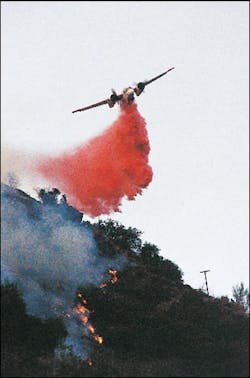Wildfire! Southern California Ends The Millennium In Flames
The 1999 wildfire season in California was historic – more fires than in past years, more acreage lost, more flight hours than ever recorded and a huge cost to extinguish the fires.
Thousands of firefighters in the area had wondered whether they would spend Christmas on the fire lines in Los Angeles and Ventura counties as three major wildland incidents erupted days before. Two of the fires, one in Glendale and one in Carpintera, were controlled, but a fire in Ojai was still being battled on Christ-mas Day.
Not even these fires would end the fire season. With less than an inch of rain since the previous winter, December temperatures remained abnormally warm and dry at the time of year when Santa Ana winds typically rake across all of the region.
The week following Christmas is generally a quiet and enjoyable period with the approach of New Year’s Day – and in Pasadena that means preparation for the Rose Parade. Just as with the week before, when fires threatened a peaceful Christmas, new fires erupted that could cause concern for New Year’s events.
On the afternoon of Dec. 27, at 2:45 P.M., the third in a series of suspicious wildfires in the Santa Anita Canyon area was burning across approximately five acres of dry, heavy fuels in extremely steep terrain. With temperatures in the area pushing 80 degrees, a mild wind gave this fire major potential.
The Firefight Begins
A full first alarm from the Angeles National Forest was augmented by an automatic aid response from the Arcadia, Monrovia and Sierra Madre fire departments as well as air support from fixed-wing aircraft and helicopters. Hand crews from Los Angeles County were requested to assist in the mountainous canyon area. There was little access for engines other than the narrow Santa Anita Canyon Road winding up to the location of the incident near the Chantry Flats campground – five miles above the city with hundreds of structures potentially in danger.
As nightfall neared, the fixed-wing aircraft made their final drops and the helicopters were returned as things on the fire line were looking good, although the fire had not yet been contained within the 50-acre fire line. As the sun went down, however, so did hope of control when gusty winds began to increase in the canyons and fire activity developed major spotting problems and runs up the steep terrain covered with brush and trees.
Immediate concern for personnel safety mounted as darkness and extreme fire conditions combined as spot fires were reported both above the road and hundreds of feet below. A final effort to hold the shaky line was no match for the new energy developing within the canyon and the more than 100 firefighters on the scene were forced to pull back from their anchor points and lines.
Immediate redeployment was directed to protect several structures in the area of the fire. Command placed an immediate-need request for 10 additional Type 1 engine strike teams (50 engines and 10 leaders) based on the threat to structures in Arcadia, Pasadena and Sierra Madre. Within three hours of near containment, the fire had now become a major wildland incident covering over 500 acres of steep, nearly inaccessible terrain with huge potential to hit populated areas and causing devastating loss.
By 8 P.M. on Dec. 27, thousands of homeowners who had been keeping their eyes on the foothills above their community were now preparing for a long night as dozens of engines arrived at staging on Santa Anita Avenue and Elkins Avenue to await their deployment assignments. The war was on.
By midnight, more than 1,000 firefighters – some who had been working on fires nine of the previous 10 days – were on the scene or responding to the incident. The fire quickly covered the carpet of unbroken fuel beds between the point of origin and the hundreds of houses below on the flatland. By 4 A.M., backfires were being set from the backyards of these endangered homes in the foothills of Sierra Madre and Arcadia. As daylight neared, a full aerial attack was committed to the incident and ground resources were in place to drive the spreading flames back away from the pricy homes depending on the success of the firefighters’ efforts.
Flames’ Advanced Stopped
At day’s light, the efforts of the firefighting force had paid off and the advance of the fire toward the homes on the southern flank had been stopped with no significant loss to property. The attack could now be concentrated on the westerly spread and to tie in and strengthen the line that had been established by morning.
With the arrival of morning, the absence of continued winds again gave firefighters hope of containing the now 750-acre fire. Engines were assigned to help handcrews improve the line around the fire, helicopters were assigned to knock down hot spots threatening the line, and fixed-wing air tankers worked the western flank to pre-treat the heavy fuel in front of the fire between the line and houses in Sierra Madre and Pasadena near the interface of the Angeles National Forest. Impressive progress continued over the second day of the incident as firefighters worked on the steep terrain. Two firefighters there were injured by falling rocks. One of the injured firefighters was removed in a spectacular hoist rescue by helicopter.
With the weather continuing to favor firefighting efforts, hundreds of area residents who had evacuated overnight returned to their homes. Expected containment of the fire would now be estimated and was set for Saturday, Jan. 1, 2000. Let the parade begin.
Keith D. Cullom, a Firehouse® correspondent, is a California-based fire service writer and photographer. He is a member of the International Fire Photographers Association (IFPA).